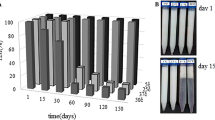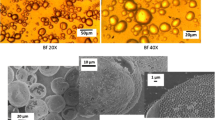Abstract
The effect of temperature on the steady-shear viscosity of two base emulsions (water-in-creosote (w/o) and creosote-in-water (o/w)) and a pigment emulsified creosote (PEC) was investigated. The PEC is a water-in-creosote emulsion which contains also a solid, micronised pigment, and is used industrially as a wood preservative. All three emulsions exhibited shear thinning characteristics at different temperatures. The viscosity-shear rate relationships follow a modified Quemada model. A temperature-superposition method using the reduced variables η/η∞ and t c \(\dot \gamma\) was applied to yield a master plot for each of these emulsions at different temperatures. The effect of creosote concentration on the viscosity of four other o/w emulsions at different temperatures was also studied. The same reduced variables were able to produce a temperature-concentration superposition plot for all of the o/w emulsion results.
The effective (average) radius of the globules (dispersed phase) was found to increase with increasing temperature for the base w/o and the PEC emulsion. The collision theory could be used to explain the increase in the droplet size. However, while little overall variation in globule size was observed for the o/w emulsions, microscopic observation indicated an increase in the proportion of large diameter droplets with temperature at the highest creosote concentration (60%). A “creaming” effect (phase concentration) was observed with these emulsions at higher temperatures, precluding an accurate estimate of droplet size based on collision theory.
Similar content being viewed by others
References
Barnes HA, Hutton JF, Walters K (1989) An introduction to rheology. Elsevier Amsterdam, The Netherlands
Chin CW, Watkins JB, Greaves H (1983) Clean creosote — its development, and comparison with conventional temperature creosote. Paper presented for the 14th meeting in Surfers Paradise, Australia
Fang TN, Tiu C (1990) A generalized rheological model for elasto-thixotropic fluids. Intern'l J Eng Fluid Mech 3(2):148–174
Greaves H, Chin CW, McCarthy KJ, Watkins JB (1985) Appearance of PEC-treated in poles in service. Paper presented at the 16th Annual Meeting, Brazil
Murray JB, Brinkies HG (1978) Use of pigment emulsified coloured creosote for timber impregnation. Report No 354. State Electricity Commission of Victoria
Quemada D (1978) Rheology of concentrated disperse system, II — A model for non-Newtonian shear viscosity in steady flows. Rheol Acta 17(6):632–642
Sadler LY, Sim KG (1991) Minimize solid-liquid mixture viscosity by optimizing particle size distribution. Chem Eng Prog 87:68–71
Tiu C, Fang TN, Chin CW, Watkins JB, Felton N, Greaves H (1990) Rheology of creosote-based wood preservative emulsions. J Chem Eng 45:B13-B25
Xu J, Stell G (1989) Bulk and shear viscosities of a polydispers hard sphere fluid. J Stat Phys 57:921–936
Author information
Authors and Affiliations
Additional information
Seconded from Koppers Coal Tar Products, Newcastle, N.S.W., Australia.
Rights and permissions
About this article
Cite this article
Tiu, C., Podolsak, A.K., Fang, T.N. et al. Rheological behavior of water-creosote and creosote-water emulsions. Rheola Acta 31, 381–389 (1992). https://doi.org/10.1007/BF00418336
Received:
Revised:
Issue Date:
DOI: https://doi.org/10.1007/BF00418336




